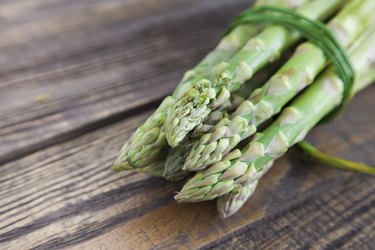
Become a renegade cook in your own kitchen by bucking the long-standing tradition of trimming and discarding the woody ends from asparagus spears. By throwing these tough, fibrous ends into the trash, you're not only missing out on nutrients that the scraps contain, you're also throwing money right into the garbage can. In the spirit of "waste not, want not," try using the ends to infuse flavor into stocks, slaws or salads. With proper preparation, these otherwise unwanted vegetable parts can be a delicious addition to your meal.
Making Stock
Video of the Day
Use stocks as a base to make soups and sauces or as a replacement for the water used for cooking rice or other grains. Because you strain the vegetables used to make the stock, the fibrous nature of the asparagus ends has no effect on the texture. Grab a large pot and throw in the asparagus ends, along with other roughly chopped vegetables such as parsnips, onions, garlic, leeks, celery, carrots, mushrooms, parsley, thyme, rosemary, bay leaf and peppercorns. Add enough water to cover the veggies and bring the mixture to a boil over medium-high heat before lowering the heat to medium-low and covering the pot. Let it simmer for about 1 hour before straining it and dividing it into storage containers.
Video of the Day
Flavoring Sauces
Slice the woody ends lengthwise, add them to a pot of hot milk or cream and allow it to steep to infuse the liquid with asparagus flavor. Let the mixture sit for approximately 15 minutes before tasting it with a clean spoon. Allow it to sit for another 10 minutes for stronger flavor. Meanwhile, melt butter in another skillet or pot, using 4 tablespoons for every 2 cups of milk. Whisk in enough all-purpose flour to create a roux -- usually 1 part flour to 2 parts butter. Pour the milk into the flour-and-butter mixture, whisking it until the resulting preparation is smooth and thickened. Add other elements such as herbs, tender asparagus tips or cooked shrimp or chicken to the sauce before tossing it with the cooked pasta of your choice.
Using Stems Raw
Just as tough cabbages break down and soften up after being dressed for coleslaw, you can also cut the woody asparagus ends into slivers to make tasty slaws and salads. Cut the ends as thinly as possible, either by hand or with a food processor or mandoline. Add sliced scallions and slivered almonds and dress with an Asian-inspired vinaigrette for an Asian asparagus slaw. Alternatively, toss slivered asparagus ends with thinly sliced zucchini, lemon juice, a drizzle of olive oil and a sprinkle of Parmesan for a fresh and simple salad.
Slicing Woody Stems for Cooking
Although the woody ends generally lack the tenderness of the tips, strategically slicing them into thin coins that are no thicker than 1/4 inch helps break the fibrous texture, leaving you with asparagus that's surprisingly tender. Another tenderizing method is to peel the outer layer from the ends with a vegetable peeler. After preparing the asparagus, steam, roast or saute it as you would the rest of the spear. Because the thinly sliced and/or shaved coins are cut into smaller pieces, use reduced cooking times to avoid overcooking them.